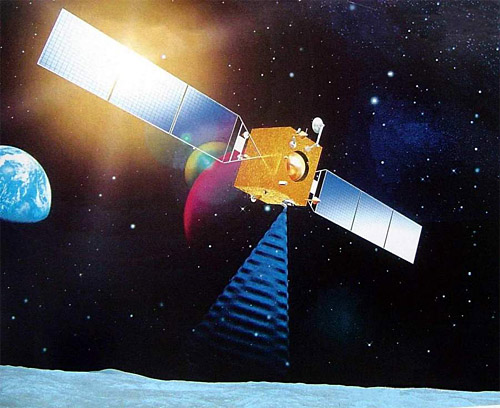| CHANG'E MOON EXPLORATION PROGRAMME
中国航天月球探险计划 Date:2016-01-08 Source:internet By:Globalmil Viewed: |

第一个月球探测器“嫦娥”(Chang'e)-1(CE-1),基于DFH-3卫星设计,预定在2007年被来自“西昌”(Xichang)卫星发射中心(XSLC)的一枚CZ-3 A运载火箭发射。月球探测器将会绘制三维月球表面地图,分析在月球表面有用的物质基础的含量和分布,测量月球土壤密度和监测近-月球空间环境。
The first lunar orbitor Chang’e-1 (CE-1), based on the DFH-3 satellite design, is scheduled to be launched by a CZ-3A launch vehicle from Xichang Satellite Launch Centre (XSLC) in 2007. The lunar orbitor will map the moon surface in three dimensions, analyse the content and distribution of useful elements on the lunar surface, measure the density of lunar soil, and monitor the near-moon space environment.
The Chinese government first announced that it was planning to carry out moon exploration and preliminary deep space research in its White Paper on China’s Space Activities published on 11 November 2000. The July 2004 edition of the Chinese aerospace magazine ‘Hangkong Zhishi’ provided more details of China’s lunar exploration programme, including a three-step plan.
在2000年11月11日出版的中国空间活动白皮书中,中国政府首次宣布正在计划完成月球探险和初步外层空间研究。2004年7月中国航空宇宙杂志《航空知识》(Hangkong Zhishi)提供了中国月球探险计划更多的资料,包括一个三阶段计划。
According to the report, the first stage is a moon orbiting mission by 2007, using the DFH-3 satellite platform. The lunar orbitor will map the moon surface in three dimensions, analyse the content and distribution of useful elements on the lunar surface, measure the density of lunar soil, and monitor the near-moon space environment. During the second stage, an unmanned moon rover will make a soft landing on the moon surface and examine the moon soil. In the third stage, an unmanned probe will be sent to the moon and collect samples of the moon soil, and then return them to earth.
依照报告,第一个阶段是2007年之前一个环月球轨道运行任务,使用DFH-3(东方红-3)卫星平台。月球观测器将会绘制三维月球表面地图,分析在月球表面有用的基础物质的含量和分布,测量月球土壤密度,而且监控近-月球空间环境。在第二个阶段的时候,一个无人操纵月亮漫游者将会在月球表面上软登陆和检查月球土壤。在第三阶段中,一个无人操纵的探测器将会被送到月球和采集月球土壤试样,然后返回地球。
In January 2004, the Chinese State Council officially approved the lunar exploration project, known as Chang’e Project. The project is named after the Chinese legend about a young fairy who flies to the moon. The total budge of the project is estimated to be 14 billion Chinese Renminbi (US$1.73 billion), with the third stage mission to be carried out by 2017. A senior official of China’s space programme claimed that once the project is completed, China may consider to send human to the moon, or even build a moon base with international co-operations.
在2004年1月,中国国务院正式地批准了月球探险计划,即是“嫦娥”(Chang'e)计划。计划依中国传说命名有关一个飞到月亮的年轻仙女的故事。计划的总预算被估计约一百四十亿人民币(十七亿三千万元美元),第三阶段任务在2017之前被实行。中国空间计划的一位资深的官员宣称一旦计划被完成,中国可能考虑送人到月球,或更甚至国际合作建立一个月球基地。
China National Space Administration (CNSA) held its first working conference for the preparations of the moon exploration project was held in Beijing in February 2004. According to the Chinese state media, the Chang’e project went smoothly since the initial study began in March 2003. Chinese space officials announced that progress on some key technologies have been made, and preliminary design of the spacecraft has started. The planned Chang'e-1 (CE-1) probe will be based on the DFH-3 bus and was to be launched by a CZ-3A booster from Xichang Satellite Launch Centre (XSLC) around 2007.
2004年2月在北京中国空间管理局(CNSA)因为月亮探险计划准备举行了它的第一个工作会议。依照中国国家媒体,自初次研究在2003年3月开始之后,“嫦娥”(Chang'e)计划平稳进行。中国空间官员宣布在一些主要技术方面已经成功,而且初步进行太空船的设计已经启动。“嫦娥”(Chang'e)-1(CE-1)探测器将基于DFH-3(东方红-3)卫星,计划将在2007年左右使用“西昌”(Xichang)卫星发射中心(XSLC)的一枚CZ-3 A运载火箭发射。
According to a report by Russian Interfax new agency on 1 November 2005, China has invited Russia to take part in its moon exploration programme. China and Russia are about to sign a new ten-year space co-operation agreement in 2007, including a possible joint moon exploration programme.
在2005年11月1日依照俄国国际传真新闻代理处的一个报告,中国已经邀请俄国参加它的月球探险计划。中国和俄国将要在2007年签署一个新的十年空间合作协议,包括一个可能的联合月球探险计划。
近几年,中国人何时在月球上留下第一行脚印,在这里插上鲜艳的五星红旗?何时建立月球基地?这都成了许多人急切想知道的问题。 根据中国已经确定的计划,中国首先要完成的是探月工程。整个探月工程分为三个阶段,第一期工程为“绕”,二期工程为“落”, 2017年进行的三期工程为“回”,之后再进行载人登月计划。
国防科工委启动了“嫦娥工程”第一期“绕月探测工程”,“嫦娥一号”(CH-1)卫星选用东方红三号(DFH-3)卫星平台,并使用运载能力为地球同步转移轨道2600公斤的长征三号甲运载火箭,在西昌卫星发射中心升空。这颗月球卫星的在轨飞行一年。星上搭载7种有效载荷,分别是用于月球表面三维影像探测的CCD相机和激光高度计,用于月表化学元素与物质探测的成像光谱仪和γ/X射线仪,用于月壤厚度探测的微波探测仪,用于地月空间环境探测的太阳高能粒子探测器和太阳风粒子探测器。
预计2007年 “嫦娥一号”升空以后,接下来“嫦娥工程”第二期就将很快进入实质性的阶段。2009年至2015年将进入嫦娥二期工程,届时将进行两到三次的软着陆巡视勘察,其中2012年向月面发射一个软着陆器的计划已经基本确定,按照这一计划软着陆器将携带载有摄像机和多种探测仪器的月球车,在月球表面巡视勘查,为建立月球基地收集基本数据资料。
中国进行此项任务的技术、物资条件和经济实力都已基本具备。据悉,二期计划中采用的月球车,将采用全国招标的方式来选择,目前国内已经有10多所科研院所和高校参与了角逐。
在此之后,中国将进行就是2017年“嫦娥工程三期”行动,即发射一颗月球无人软着陆器,这个软着陆器不仅要采集月壤和岩石的样本,还要搭乘返回舱重返地球。在这个阶段中,空间机器人将会充当主要角色,在卫星维修、太空科学试验等活动中发挥重要作用。据悉,为了尽快实施机器人登月计划,国家早已经成立了第一个空间机器人的专门研究机构,即国家高技术航天领域空间机器人工程研究中心,并且空间机器人已经进入研制程序。
“嫦娥工程三期”完成以后,载人登月计划将会成为“嫦娥工程”的第四期工程。根据科学家的设计,我国所计划采用的方式是先用运载火箭将飞船送上地球轨道,随后,飞船自行移动至月球轨道,释放出登陆舱,降落在月球表面,宇航员登陆月球。活动完成后,宇航员返回登陆舱,飞离月球,与在月球轨道上等待的飞船重新对接,至此登月过程结束。
随着神舟四号飞船的上天,中国很快就将在载人航天领域跨出自己那炫目的一步。至此,航天领域的“三驾马车”中,中国在卫星应用、载人航天两个方面快马加鞭,取得了让世人叹服的成就。 于是,中国航天人又将探寻的目光转向了月球。他们希望,中国月球探测计划的提出和实施,能成为我国迈向深空探测的第一步。
探月三步走,走出自己特色
2000年11月,中国发表《中国的航天》白皮书,发展目标中明确提出“开展以月球探测为主的深空探测的预先研究”。由此,我国月球探测计划开始“浮出水面”。
在制定计划时,航天专家普遍达成共识:虽然我们起步较晚,但中国的月球探测活动不会重复别人已经做过的工作。中国的月球探测计划起点要高,要有特色,要科学地选择我国进行月球探测的目标,既要填补我国月球探测的空白,也要为人类建立月球基地增添新的科学依据。
根据中国月球探测计划首席科学家、国家天文台欧阳自远院士介绍,我国月球探测计划将分三步走:
第一步,利用我国现有技术和条件,向月球发射月球探测卫星。月球探测卫星将绕环月轨道运行,对月球进行遥感探测,除了探明月球上蕴藏丰富的氦3、铁、钛、水冰等能源和资源外,还将查明月球表面的环境、地貌、地质构造与物理场,争取对月球的形貌特征、资源性元素分布规律及开发利用前景有一个初步认识。
事实上,中国为探测月球所做的准备已经开始了。据了解,包括多家高校在内的研究机构,正在展开研制月球车的“竞赛”,一些研究机构因为月球车研制技术日益成了宣传,期望在日后的月球探测计划技术招标中,自己设计的月球车能够受到青睐。
中国还专门成立了一个空间机器人的研究机构,该中心已设计出多种太空机器人,其中用于月球表面探测的机器人轻小灵巧,会自由移动、爬坡和躲避障碍,并能适应月球上大温差和辐射等环境。
长三甲火箭加东方红三号卫星
“探月三步走”已确定,但第一步如何走?我国将采取什么方法,怎样发射自己的月球探测卫星?这始终还是个谜。
不久前,在北京航空制造工程研究所组织的一次学术报告会上,中国运载火箭研究院火箭总指挥龙乐豪院士抑制不住自己的激动,向人们讲述了正在酝酿中的我国月球探测第一步计划的大致构想。
龙院士介绍,采用多级大推力火箭,发射1至2吨的月球探测器进入环月轨道,环绕月球进行探测,是我国首次月球探测计划的基本设想。
“使用长三甲火箭作运载工具,将东方红三号卫星稍作改进,依靠现有技术,一旦立项,我国有望在3年内发射月球探测卫星。”龙院士的乐观是大家始料未及的。
航天界人士认为,其实我国已具备发射月球探测卫星的技术条件。
一个不可否认的事实是,虽然我国航天技术与国外先进水平相比还有很大差距,但运载火箭技术及动载能力却大大超过美国和前苏联三四十年前进行第一轮探月时的能力。
酝酿中的我国探月计划,运载火箭一共有三大类型九种方案可供选择。其中,我国自行研制的长三甲系列的3种火箭,可分别将1600千克、2400千克和3300千克的探测器直接送入奔月轨道,由于它们运载能力大,并且已成功进行过10次发射,因此长三甲火箭是发射探月飞行器首选。
专家们还乐观估计,即使是在将来,在月球探测器既要在月球表面着陆,又要从月球返回地球,所需的发射质量较大的情况下,中国规划中的最大运载能力达到28吨的新一代运载火箭,也能完全满足要求。
一切顺利的话中国会在2025年开始载人登月计划。
上一篇:SHENZHOU-1/2/3/4 UNMANNED SPACEFLIGHT MISSION 下一篇:TianGong 1 Spaceflight Mission
| TianGong 1 Spaceflight Mission
中国天宫(TianGong) 1航天任务 |
| As the first step, China will launch TianGong 1, also known as “target spacecraft”... [2020-12-08] |
| CHANG'E MOON EXPLORATION PROGRAMME
中国航天月球探险计划 |
| The Chinese government first announced that it was planning to carry out moon exploration and preliminary deep space research in its White Paper on China’s Space Activities published on 11 November 2000.... [2016-01-08] |
| SHENZHOU-1/2/3/4 UNMANNED SPACEFLIGHT MISSION
中国“神舟”-1/2/3/4无人操纵航天飞行任务 |
| Between November 1999 and December 2002, China launched four unmanned experimental spaceships to test the launch vehicle, spaceship, and life support systems onboard.... [2016-01-08] |
| PROJECT 921-III (SPACE STATION)
中国航天921-III计划(空间站) |
| In the third stage of the Chinese manned spaceflight programme, which is known as Project 921-III, China is going to build a permanent space station where astronauts can live for a long period (few months) and conduct various scientific expe... [2016-01-08] |
